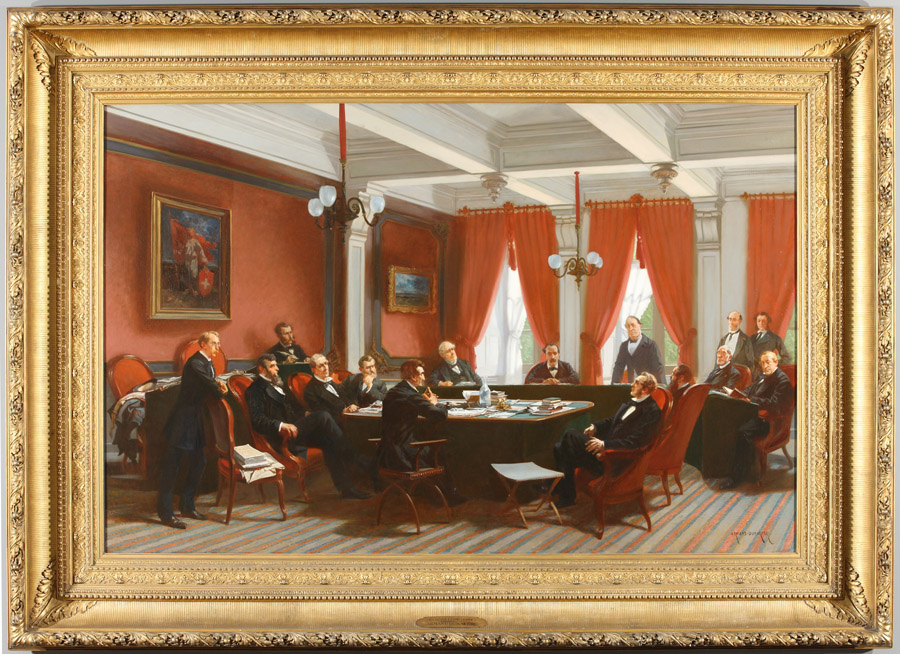Admiral Raphael Semmes
Camp #11
Sons of COnfederate Veterans
Mobile, Alabama
COMMEMORATION of the first international arbitration
Nestled in Langan Park is the Mobile Museum of Art. This impressive modern structure houses a surprising variety of art. Just beyond the grand lobby is the Maisel European Gallery, which contains a variety of works that pay homage to the nautical life of the 19th Century. Prominently displayed in this room is a recreation of a scene from the historic event of the First International Arbitration that took place in Geneva, Switzerland in 1869-1872. It was this negotiation that led to the United Kingdom paying the United States 15 million dollars for the damage to commercial shipping industry by the CSS Alabama.
This international arbitration was so successful in its outcome that it served as a precursor to the Hague Convention, the League of Nations, the World Court and, ultimately, the United Nations.
This international arbitration was so successful in its outcome that it served as a precursor to the Hague Convention, the League of Nations, the World Court and, ultimately, the United Nations.
Artist: Charles Edouard Armand-Dumaresq
French, 1826 - 1895
Title: THE GENEVA CONFERENCE, THE ALABAMA ARBITRATION
Painted: Circa 1873
Medium: Oil on canvas
Framed size: 72 5/8" H x 100 5/8" W x 6" D
Gift from Mr. & Mrs. Kenneth R. Giddens
Catalogue Number: G81.29.01
Image Courtesy of the Mobile Museum of Art
*Currently not on exhibit.
French, 1826 - 1895
Title: THE GENEVA CONFERENCE, THE ALABAMA ARBITRATION
Painted: Circa 1873
Medium: Oil on canvas
Framed size: 72 5/8" H x 100 5/8" W x 6" D
Gift from Mr. & Mrs. Kenneth R. Giddens
Catalogue Number: G81.29.01
Image Courtesy of the Mobile Museum of Art
*Currently not on exhibit.
ACCOMPANYING Didactic
by Paul W. Richelson, Chief Curator Emeritus, MMOA
The Geneva Conference belongs to the long-standing artistic tradition of history painting. This conference was the first ever organized to specifically arbitrate international disputes, making it a worthy subject: its success set the stage for the creation of the League of Nations, the International Court of Justice, and eventually the United Nations.
Charles Edouard Armand-Dumaresq painted portraits of fifteen historical figures shown gathered in Geneva at Hotel-de-Ville in a room that today bears the name of the ship precipitating that historical event—Salle de l’Alabama (Alabama Room). From December 15, 1871, to September 14, 1872, appointed statesmen met to adjudicate the claims made by the United States that Great Britain had violated the terms of neutrality during the American Civil War. At issue was the largely British crew of the famous Confederate raider the CSS Alabama, built by the Laird Company in Birkenhead, England, and commanded by Captain Admiral Semmes, a Mobile legend. The raider inflicted heavy losses on Union ships before it was destroyed on June 19, 1864, by the warship USS Kearsarge off Cherbourg, France.
The composition shows the diplomats’ final meeting as they calmly and seriously hand down their decision that Great Britain should pay the United States $15.5 million in gold (the United States had asked for $8 billion). In addition, the conference settled on a definition of neutrality, as well as clarifying maritime and reparation laws. Included among the sitters are Alexander Favrot, the official secretary, who is shown at the writing desk with his pen in hand; Charles Francis Adams, the son of President John Quincy Adams; Jacques Saempfli; Count Frederico Sclopis, conference president; and Hamilton Fish, the Secretary of State of the United States, who is shown as an observer. Armand-Dumaresq was commissioned to paint the conference while it was in session, thus ensuring the accuracy of the diplomats’ likenesses.
Charles Edouard Armand-Dumaresq painted portraits of fifteen historical figures shown gathered in Geneva at Hotel-de-Ville in a room that today bears the name of the ship precipitating that historical event—Salle de l’Alabama (Alabama Room). From December 15, 1871, to September 14, 1872, appointed statesmen met to adjudicate the claims made by the United States that Great Britain had violated the terms of neutrality during the American Civil War. At issue was the largely British crew of the famous Confederate raider the CSS Alabama, built by the Laird Company in Birkenhead, England, and commanded by Captain Admiral Semmes, a Mobile legend. The raider inflicted heavy losses on Union ships before it was destroyed on June 19, 1864, by the warship USS Kearsarge off Cherbourg, France.
The composition shows the diplomats’ final meeting as they calmly and seriously hand down their decision that Great Britain should pay the United States $15.5 million in gold (the United States had asked for $8 billion). In addition, the conference settled on a definition of neutrality, as well as clarifying maritime and reparation laws. Included among the sitters are Alexander Favrot, the official secretary, who is shown at the writing desk with his pen in hand; Charles Francis Adams, the son of President John Quincy Adams; Jacques Saempfli; Count Frederico Sclopis, conference president; and Hamilton Fish, the Secretary of State of the United States, who is shown as an observer. Armand-Dumaresq was commissioned to paint the conference while it was in session, thus ensuring the accuracy of the diplomats’ likenesses.
